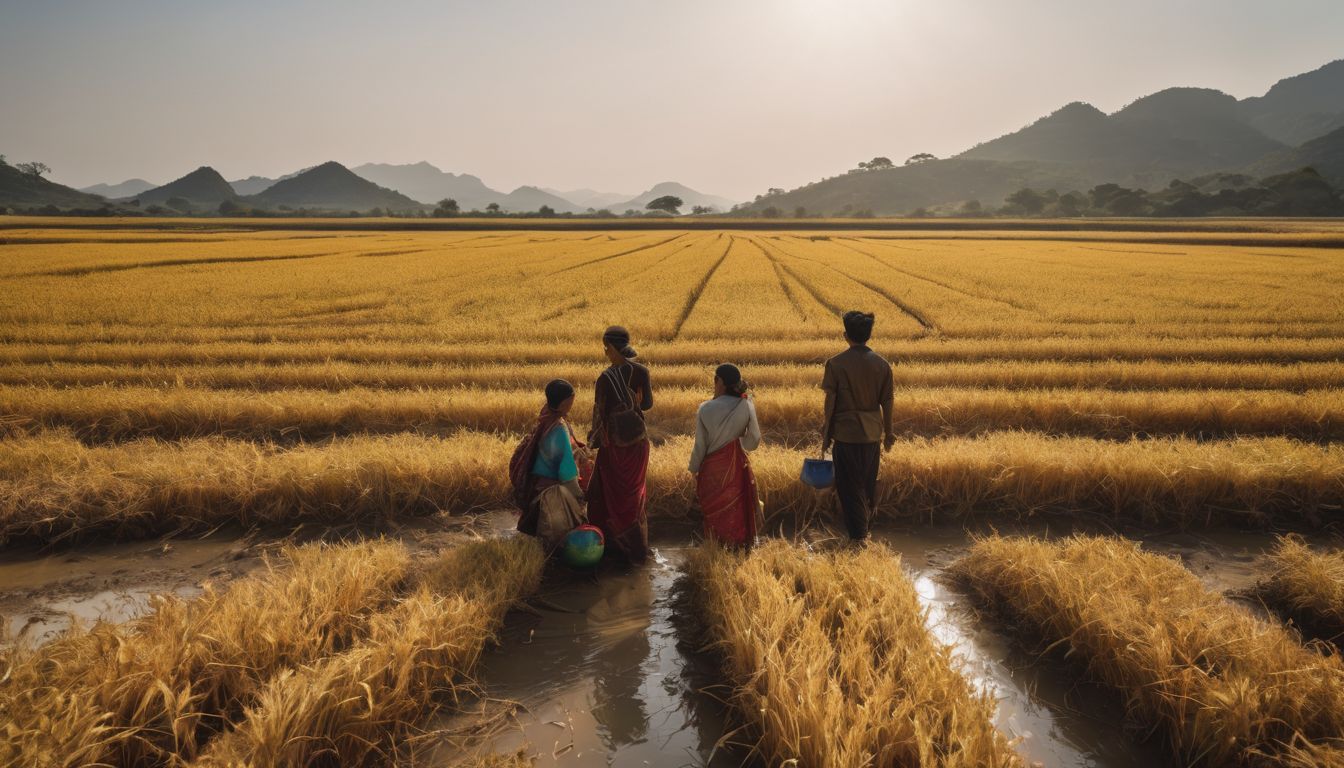Weather extremes are hitting closer to home than we ever thought possible, rocking our worlds with record-breaking storms and scorching heatwaves. Research reveals that for every degree Celsius our planet warms, the atmosphere can hold 7% more moisture, setting the stage for devastating floods and relentless rainfall.
Our article delves into these dramatic shifts, highlighting ways you can contribute to curbing this global upheaval. Dive in to unearth how your actions can foster a cooler tomorrow.
Key Takeaways
- Global warming leads to a 7% increase in atmospheric moisture for every degree Celsius rise, causing more intense and frequent floods, storms, and heatwaves.
- Rising temperatures from climate change are worsening heatwaves, droughts, and leading to heavier snowfalls and frigid weather events that disrupt daily life.
- Evidence from scientific research unequivocally shows a link between human – caused climate change and the changing patterns of extreme weather events such as hurricanes and blizzards.
- Extreme weather like droughts affects crop productivity leading to economic hardships, while sea level rise puts coastal communities at increased risk of flooding.
- Taking action against global warming involves reducing carbon emissions through renewable energy use, sustainable transport options, advocating for green policies, preparing emergency plans for extreme weather events.
Understanding Extreme Weather Events
Extreme weather events, such as hurricanes, heatwaves, and heavy rainfall, are characterised by their severity and impact on communities. These events can lead to significant damage to infrastructure, loss of life, and long-term economic consequences.
Definition of extreme weather
Extreme weather includes any severe or unusual weather phenomena—such as hurricanes, tornadoes, blizzards, heatwaves, and heavy rainfall—that significantly deviate from the expected patterns in a given region.
These events often cause significant disruption to communities and ecosystems. As the planet’s temperature continues rising due to global warming, these incidents are becoming more frequent and intense.
Weather disasters like prolonged droughts or devastating floods reflect the growing impact of climate change on our world’s weather systems. With greenhouse gases trapping more heat in the atmosphere, we’re witnessing changes that heighten not just temperatures but also variability in precipitation patterns and storm intensity.
Moving forward from understanding what constitutes extreme weather events is crucial as it informs our discussion about their link with climate change—an issue that spans scientific research to urban planning strategies.
Examples of extreme weather events
- Heatwaves, which can lead to dehydration, heatstroke, and even death in vulnerable populations.
- Droughts, causing water scarcity, crop failure, and negative impacts on ecosystems and wildlife.
- Intense storms and floods, resulting in property damage, displacement of communities, and loss of lives.
- Heavy snowfall and frigid temperatures, affecting transport, infrastructure, and daily life.
- Rising sea levels leading to coastal flooding, erosion of shorelines, and destruction of coastal habitats.
- Severe winter storms that disrupt daily activities and pose risks to health and safety.
The Link Between Climate Change and Extreme Weather
Scientific research has provided clear evidence of the link between climate change and extreme weather, showing the impact of rising temperatures on the intensity and frequency of extreme weather events.
This human fingerprint on extreme weather highlights the urgent need for action against global warming to mitigate future climate disasters.
Evidence from scientific research
Scientific research provides clear evidence of the link between climate change and extreme weather events. Research shows that global warming intensifies the frequency and severity of extreme weather such as heatwaves, storms, and floods.
The human fingerprint on extreme weather is becoming more pronounced, with rising temperatures attributed to carbon pollution. Climate science research unequivocally demonstrates the impact of climate change on changing weather patterns and the increasing intensity of natural disasters.
Furthermore, scientific studies highlight the urgent need for action to address global warming in order to mitigate its impact on extreme weather events. The findings underscore the importance of reducing carbon emissions and supporting sustainable solutions to combat climate change.
Impact of climate change on extreme weather
Climate change has unquestionably intensified extreme weather events. Rising global temperatures are causing more frequent and severe heatwaves, droughts, storms, floods, snowstorms, and coastal flooding.
The evidence from scientific research is overwhelming: the warming climate significantly contributes to the increasing frequency and intensity of these disasters. Sea level rise further exacerbates the impact of extreme weather events on coastal communities.
Extreme heat caused by climate change poses a significant threat to human health and well-being. Droughts are becoming more prolonged and devastating in many regions due to changing precipitation patterns linked with global warming.
Storms and floods are also intensifying, leading to widespread destruction of property and infrastructure. As snowfall patterns shift due to rising temperatures, winter storms become more unpredictable, affecting transportation systems and daily life.
Types of Extreme Weather Events Affected by Global Warming
Extreme weather events such as heatwaves, storms, and floods have been exacerbated by global warming. These events pose a significant threat to both human populations and the environment.
Heat and drought
Global warming is causing more intense heatwaves and prolonged periods of drought. This has significant repercussions on the environment, agriculture, and human health.
- Higher temperatures lead to increased evaporation, drying out soil and vegetation, worsening drought conditions.
- Drought affects crop productivity, leading to food shortages and economic hardship.
- Increased heatwaves pose health risks, particularly for vulnerable populations such as children and the elderly.
- Wildfires are exacerbated by prolonged periods of hot and dry weather, causing widespread destruction and air pollution.
- Water scarcity becomes a critical issue during droughts, impacting drinking water supplies and ecosystems.
- Extreme heat can damage infrastructure such as roads, railways, and power lines.
Storms and floods
Storms and floods are becoming more frequent and severe due to global warming. Intense rainfall and stronger hurricanes are causing devastating flooding in many areas, leading to widespread destruction. Coastal regions are particularly vulnerable to storm surges and flash flooding, putting communities at risk of displacement and infrastructure damage.
- Heavy rainfall from storms can overwhelm drainage systems, causing urban flooding and water contamination.
- Rising sea levels exacerbate the impact of storm surges, increasing the likelihood of coastal flooding.
- Floods not only damage homes and businesses but also pose threats to public health by creating breeding grounds for disease-carrying insects.
Snow and frigid weather
- Heavy snowfall and blizzards: Increased moisture in the atmosphere due to global warming can result in heavier snowstorms, causing disruptions in transport and infrastructure while creating safety hazards.
- Ice storms: Rising temperatures can lead to more frequent freezing rain events, resulting in hazardous icy conditions that pose risks to trees, power lines, and human safety.
- Polar vortex shifts: Changes in atmospheric circulation patterns due to climate change may cause alterations in the polar vortex, leading to extreme cold snaps and frigid temperatures affecting regions unaccustomed to such harsh winter conditions.
- Impact on wildlife: Snow and frigid weather can disrupt ecosystems, affecting the survival of various species of plants and animals dependent on specific winter conditions for their life cycles.
- Challenges for agriculture: Extreme cold events coupled with heavy snowfall can impact agricultural activities by causing crop damage, livestock losses, and logistical challenges for farmers.
- Infrastructure vulnerabilities: The increased frequency of intense winter weather can strain infrastructure systems such as power grids, water treatment facilities, and transport networks due to heightened demands during severe weather conditions.
Sea level rise and coastal flooding
As we transition from the impact of snow and frigid weather to the escalating effects of global warming, it’s important to recognise the threat of rising sea levels and coastal flooding. These consequences are a direct result of climate change and have significant implications for our environment, wildlife, and communities.
- Sea level rise is attributed to melting polar ice caps and glaciers due to warmer temperatures, leading to heightened water levels globally.
- Coastal flooding poses an imminent risk to low – lying areas, increasing the likelihood of devastating inundation during extreme weather events.
- Both phenomena directly endanger coastal ecosystems, including wetlands and estuaries, which serve as crucial habitats for a diverse range of species.
- In addition to ecological concerns, rising sea levels threaten human settlements in coastal regions and exacerbate the vulnerability of these areas to storm surges and high tides.
- The urgency to address these challenges calls for proactive measures such as shoreline restoration, strategic urban planning, and sustainable infrastructure development tailored for resilience against coastal flooding.
Winter storms
Winter storms occur when cold air masses collide with warm air masses, leading to heavy snowfall, ice, and strong winds. These intense weather events can cause power outages, transportation disruptions, and damage to infrastructure. They can also pose serious risks to human safety and health. Key impacts of winter storms include:
- Reduced visibility due to heavy snow or blowing snow.
- Increased risk of accidents on roadways and highways.
- Disruption of public services such as electricity and water supply.
- Damage to buildings and structures from heavy snow accumulation.
- Strain on emergency services for rescue operations and medical assistance.
Taking Action Against Global Warming and Extreme Weather
To combat global warming and extreme weather events, it is crucial to reduce carbon emissions, support sustainable solutions, and prepare for and respond to the impacts of extreme weather.
This requires collective effort from individuals, communities, businesses, and governments to mitigate the effects of climate change.
Reduce carbon emissions
To protect our planet from the escalating effects of global warming and extreme weather events, it’s crucial that we all play our part in reducing carbon emissions. Here are some practical actions to take:
- Opt for renewable energy sources such as solar or wind power for your home.
- Use public transport, car share, walk, or cycle instead of driving alone.
- Choose energy – efficient appliances and lighting options.
- Support businesses and industries that prioritise sustainability and low – carbon practices.
- Advocate for policies that promote clean energy and reduce dependence on fossil fuels.
Support sustainable solutions
Support sustainable solutions by choosing renewable energy sources such as solar or wind power. This reduces the demand for fossil fuels and decreases carbon emissions, helping to mitigate climate change. Additionally, advocate for and invest in sustainable transportation options, like electric vehicles or public transport, which further reduce carbon emissions and minimise environmental impact. Incorporate energy-efficient practices into your daily life, such as utilising LED lighting, reducing water consumption, and properly insulating homes to decrease energy usage. Support policies that promote sustainable land use practices and conservation efforts to protect ecosystems and biodiversity. Lastly, encourage businesses and industries to adopt sustainable practices and technologies to minimise their environmental footprint.
Prepare for and respond to extreme weather events
Prepare for and respond to extreme weather events:
- Create an emergency plan for your family, including a communication strategy and designated meeting points.
- Build or stock up on an emergency kit with essential supplies such as food, water, first aid items, and important documents.
- Stay informed about extreme weather warnings and advisories through reliable sources like local news channels, weather apps, or community alert systems.
- Educate yourself about evacuation routes in your area and have a plan in place for where to go if you need to leave your home.
- Support local initiatives that focus on disaster preparedness and response, such as volunteer organisations or community emergency response teams.
- Advocate for policies that prioritise climate resilience and support funding for infrastructure improvements to mitigate the impact of extreme weather events.
Conclusion
In conclusion, global warming is intensifying extreme weather events worldwide. Action is needed to reduce carbon emissions and support sustainable solutions. We must also prepare for and respond effectively to the increasing frequency of extreme weather events.
It’s crucial that we address the climate crisis by taking decisive action now. Let’s work together to protect our planet for future generations.
FAQs
1. What does global warming have to do with extreme weather?
Global warming is causing the climate crisis, which increases the intensity of extreme weather events like storms and heatwaves.
2. Are we seeing more weather disasters because of global warming?
Yes, as the Earth gets warmer due to global warming, we are experiencing more frequent and severe weather disasters around the world.
3. Can stopping global warming reduce extreme weather events?
If we take action against global warming now, we can slow down climate change and potentially reduce the number of future extreme weather events.
4. How can I learn about protecting myself from extreme weather caused by global warming?
To protect yourself from intense extreme weather fueled by global warming, stay informed through reliable sources and follow safety guidelines issued by experts.





